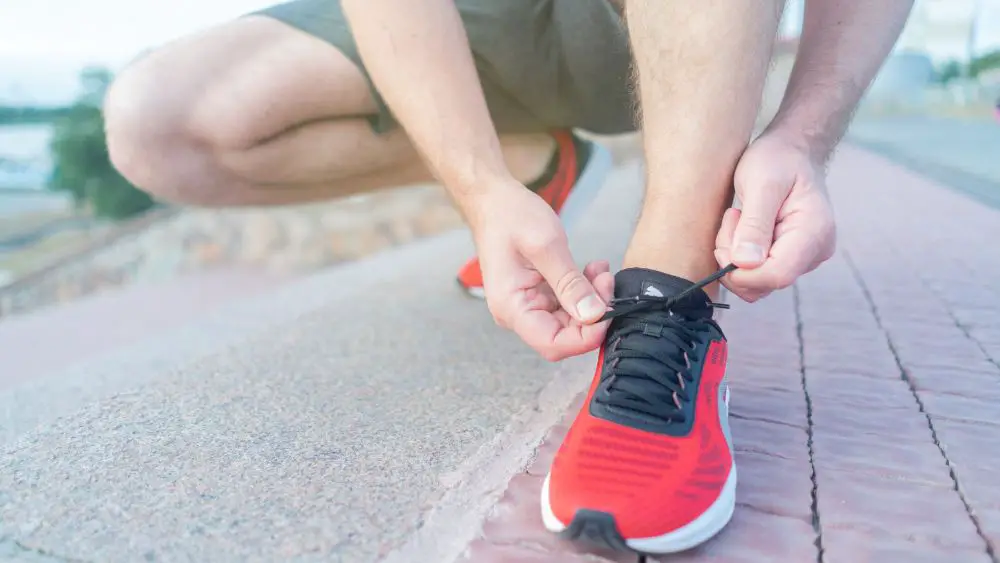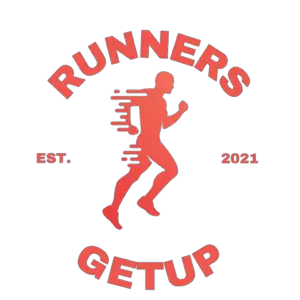This post contains affiliate links.
Have you ever worn running shoes that caused discomfort and pain halfway through your intended distance? I know I have. I’ve tried and tested many shoes in different sizes over my running years and made some observations on the signs of wearing the wrong shoes.
Ahead, we’ll talk about 7 tell-tale signs that you’re wearing the wrong shoe size. Then, we will give you some tips on how to find the right shoe fit.
Here are the 7 signs that your shoes have the wrong size:

1. Your feet hurt when running
The most obvious sign that you’re wearing the wrong shoe size is pain or discomfort when running. In most cases, you’ll know that a shoe will cause problems down the road the moment you slip your feet on for a run. If you feel any sort of pain or discomfort just by wearing the shoe, imagine how it will feel when you start running.
The common pain points are:
- The heel
- The outer side of the foot
- The arch
- Toes
- The bunions
When your feet hurt, the shoe is either too big, too small, or simply the wrong shape for your foot.
2. You’re getting blisters everywhere
Blisters are characterized by redness and watery pulps. It is usually caused by friction and is commonly seen in the heels, foot arch, toes, and even underfoot.
Everyone knows how annoying blisters can be! They are itchy, painful, and tough to deal with, especially if their origin is always grazed by your shoes. And the worst part about running blisters is that they feel tolerable in the first few miles which will encourage you to keep going until it becomes too large.
If you notice blisters after running, then chances are high that your shoes are in the wrong size.
Blisters located on the toes usually imply that your gear is too narrow. Sometimes you will see these blisters in between your toes because the shoe is not leaving enough space for them to sprawl causing them to rub each other instead.
Blisters on the heels usually mean the shoes are too big or the heel counter isn’t stable enough. Heel blisters are caused by friction in the heel as you run.
Lastly, blisters on the arch or near the ball of the feet usually mean that the shoes are too big in terms of width. The sole of your feet just glides around during impact since it is not snug and tight.
Sometimes, foot blisters when running can be fixed by wearing the right socks. If the problem persists, ditch your running shoe.
By the way, I compiled a list of the best running socks that prevent blisters that I personally used. If you’re having foot blister problems, you might want to give these socks a shot.
3. You do not need to unlace to remove them
You might have done this with your casual sneakers quite easily, and that’s because casual sneakers aren’t designed to be used when running hundreds of miles. Running shoes, on the other hand, should fit snuggly so that your foot shouldn’t be able to slide in and out of them without removing the laces.
If you can remove your feet from the shoes without needing to unlace them, then your shoes are too big. It means that space is abundant within the shoe since it takes little to no effort for your feet to get out.
Subsequently, the opposite also applies. If you need to unlace everything just to remove your shoe comfortably, then it is too small.
4. Bruised Toes and Corn
A bruised toe (particularly the biggest and longest ones) is a tell-tale sign that your shoes are the wrong size. A bruised toe (or black toe) is a result of repeatedly hammering the toes to the tip of the shoe. Hence, it results in black or bruised toes.
This condition is so common among runners that they named it runner’s toe, a condition wherein the region is completely blackened due to recurring strain. If not prevented, this can even result in your toenails falling off. And let me tell you from first-hand experience, you won’t like it.
Other conditions that are also associated with tight running shoes are corns and calluses. These are thick and hard layers of additional skin as it tries to protect itself from friction. When cramped shoes restrict the feet, it causes friction in the area which leads to such conditions.
Wearing the wrong type of socks can also be a culprit, so make sure that it is also accounted for.
5. Leg pains
Having a running shoe that is too small or too big will cause changes in running gait as a result of overcompensation. Although the changes in gait may not be observable, over a long distance you’ll eventually feel soreness in select muscles that you previously don’t cause any problems when your run.
6. Burning feet
Burning feet refers to a very hot feeling on the soles, balls of the feet, or toes while running. While it might seem like just a slight annoyance at first, it can quickly turn into serious blisters when left off.
This usually happens when your shoes slide around your shoes brought about by wrong sizing or wrong fit. Wearing thick socks and adding some vaseline usually helps with this temporarily. However, proper fitting of your running shoes is a much better solution in the long run.
7. You can’t lift your toes
Being unable to lift your toes means that there is not enough room for movement. Always take note of this when purchasing your shoes, as it can be easily prevented with good presence of mind. Aside from that, the same condition exists if you notice that your toes rub against each other.
A good rule to follow is to make sure that the end of your smallest toe is not folded at all. Remember that different shoes have different shapes, so always use one that follows your natural mold.
Finding the Right Shoe Size
The perfect running shoes are those that are not too tight but not too loose. It should be able to protect you from the elements of the road while giving a sense of comfort and safety. Since different runners have different feet, choosing one is highly dependent on your needs and preferences.
However, one must take note that good sizing for running shoes is more than just the physical measurement, it is also all about the general “feel” of the gear.
Hence, it is always recommended to try out multiple pairs before purchasing to see which one is better suited. You can even choose a narrow or wide version of the same shoe if needed.
A good rule of thumb to follow is to leave half a thumb to a thumb’s width between the edge of the shoe tip of the shoe and your longest toe. This should give your feet enough room to breathe without being too loose.
Lastly, is to check the general width of the shoe and account for pressure distribution. Good shoes should promote equal distribution of weight so that injuries are avoided. Comfort should be put above and beyond aesthetics, as running shoes are made to protect and preserve your feet.
Recommended read: How Running Shoes Should Fit (3 Steps To Finding Your Shoe Size)
Final Thoughts
Good running shoes always equate to a good running experience. If you have shoes that do not fit you well, then you will be more concerned about your shoe performance rather than your running ability. Once you see these signs, then it is time to get gear that fits you well. Safety and enjoyment will follow each other in your runs!
My Recommended Gear
Hey, if you’re looking for the perfect running gear and you’re having a hard time choosing one, I’ve compiled a list of my favorites below.
- Neutral running shoes: Brooks Ghost 14
- Stability Running Shoes: Brooks Adrenaline GTS 21
- Running shorts: Lixada 2-in-1 Running Shorts
- Running Underwear: Runderwear Chafe-Free Underwear
- Running Socks: Balega UltraGlide
- GPS Running Watch: Coros Pace 2

